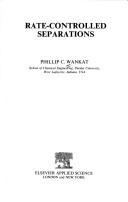| Listing 1 - 3 of 3 |
Sort by
|

ISBN: 1851665706 1851665218 9781851665709 9781851665211 Year: 1990 Publisher: London ; New York : Elsevier Applied Science,
Abstract | Keywords | Export | Availability | Bookmark
 Loading...
Loading...Choose an application
- Reference Manager
- EndNote
- RefWorks (Direct export to RefWorks)
Book
ISBN: 9780137468041 Year: 2023 Publisher: Boston : Pearson,
Abstract | Keywords | Export | Availability | Bookmark
 Loading...
Loading...Choose an application
- Reference Manager
- EndNote
- RefWorks (Direct export to RefWorks)
Efficient separation processes are crucial to addressing many societal problems, from developing new medicines to improving energy efficiency and reducing emissions. "Separation Process Engineering", Fifth Edition, is the most comprehensive, accessible guide to modern separation processes and the fundamentals of mass transfer. In this completely updated edition, Phillip C. Wankat teaches each key concept through detailed, realistic examples using actual data--with up-to-date simulation practice, spreadsheet-based exercises, and references.Wankat thoroughly covers each separation process, including flash, column, and batch distillation; exact calculations and shortcut methods for multicomponent distillation; staged and packed column design; absorption; stripping; and more. His extensive discussions of mass transfer and diffusion enable faculty to teach separations and mass transfer in a single course. And detailed material on liquid-liquid extraction, adsorption, chromatography, and ion exchange prepares students for advanced work.New and updated content includes melt crystallization, steam distillation, residue curve analysis, batch washing, the Shanks system for percolation leaching, eutectic systems, forward osmosis, microfiltration, and hybrid separations. A full chapter discusses economics and energy conservation, including updated equipment costs. Over 300 new and updated homework problems are presented, all extensively tested in undergraduate courses at Purdue University.
Book
ISBN: 1612493610 9781612493619 9781612493626 1612493629 1557537003 9781557537003 9781557537003 Year: 2015 Publisher: Purdue University Press
Abstract | Keywords | Export | Availability | Bookmark
 Loading...
Loading...Choose an application
- Reference Manager
- EndNote
- RefWorks (Direct export to RefWorks)
The majority of professors have never had a formal course in education, and the most common method for learning how to teach is on-the-job training. This represents a challenge for disciplines with ever more complex subject matter, and a lost opportunity when new active learning approaches to education are yielding dramatic improvements in student learning and retention. This book aims to cover all aspects of teaching engineering and other technical subjects. It presents both practical matters and educational theories in a format useful for both new and experienced teachers. It is organized to start with specific, practical teaching applications and then leads to psychological and educational theories. The "practical orientation" section explains how to develop objectives and then use them to enhance student learning, and the "theoretical orientation" section discusses the theoretical basis for learning/teaching and its impact on students. Written mainly for PhD students and professors in all areas of engineering, the book may be used as a text for graduate-level classes and professional workshops or by professionals who wish to read it on their own. Although the focus is engineering education, most of this book will be useful to teachers in other disciplines. Teaching is a complex human activity, so it is impossible to develop a formula that guarantees it will be excellent. However, the methods in this book will help all professors become good teachers while spending less time preparing for the classroom. This is a new edition of the well-received volume published by McGraw-Hill in 1993. It includes an entirely revised section on the Accreditation Board for Engineering and Technology (ABET) and new sections on the characteristics of great teachers, different active learning methods, the application of technology in the classroom (from clickers to intelligent tutorial systems), and how people learn.
Engineering --- Study and teaching (Higher) --- Teaching skills & techniques
| Listing 1 - 3 of 3 |
Sort by
|

 Search
Search Feedback
Feedback About UniCat
About UniCat  Help
Help News
News